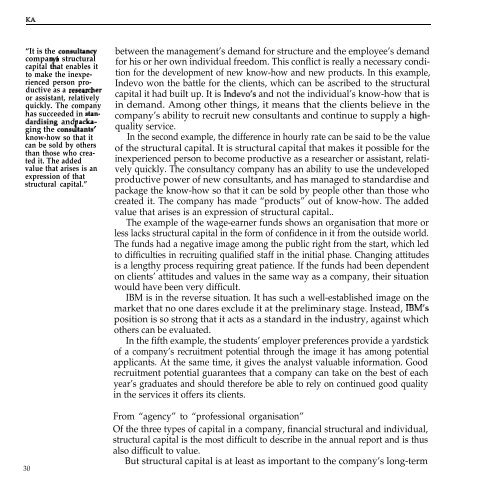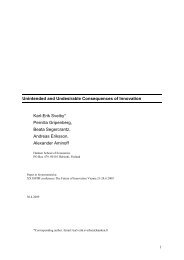Invisible Balance Sheet - Sveiby Knowledge Management
Invisible Balance Sheet - Sveiby Knowledge Management
Invisible Balance Sheet - Sveiby Knowledge Management
Create successful ePaper yourself
Turn your PDF publications into a flip-book with our unique Google optimized e-Paper software.
“It is the consultancy<br />
compan s structural<br />
capital Lat<br />
enables it<br />
to make the inexperienced<br />
person productive<br />
as a reseamher<br />
or assistant, relatively<br />
quickly. The company<br />
has succeeded in standardizing<br />
and acka-<br />
ging the consu rtants’<br />
know-how so that it<br />
can be sold by others<br />
than those who created<br />
it. The added<br />
value that arises is an<br />
expression of that<br />
structural capital.”<br />
30<br />
between the management’s demand for structure and the employee’s demand<br />
for his or her own individual freedom. This conflict is really a necessary condition<br />
for the development of new know-how and new products. In this example,<br />
Indevo won the battle for the clients, which can be ascribed to the structural<br />
capital it had built up. It is Indevo’s and not the individual’s know-how that is<br />
in demand. Among other things, it means that the clients believe in the<br />
company’s ability to recruit new consultants and continue to supply a highquality<br />
service.<br />
In the second example, the difference in hourly rate can be said to be the value<br />
of the structural capital. It is structural capital that makes it possible for the<br />
inexperienced person to become productive as a researcher or assistant, relatively<br />
quickly. The consultancy company has an ability to use the undeveloped<br />
productive power of new consultants, and has managed to standardise and<br />
package the know-how so that it can be sold by people other than those who<br />
created it. The company has made “products” out of know-how. The added<br />
value that arises is an expression of structural capital..<br />
The example of the wage-earner funds shows an organisation that more or<br />
less lacks structural capital in the form of confidence in it from the outside world.<br />
The funds had a negative image among the public right from the start, which led<br />
to difficulties in recruiting qualified staff in the initial phase. Changing attitudes<br />
is a lengthy process requiring great patience. If the funds had been dependent<br />
on clients’ attitudes and values in the same way as a company, their situation<br />
would have been very difficult.<br />
IBM is in the reverse situation. It has such a well-established image on the<br />
market that no one dares exclude it at the preliminary stage. Instead, IBMs<br />
position is so strong that it acts as a standard in the industry, against which<br />
others can be evaluated.<br />
In the fifth example, the students’ employer preferences provide a yardstick<br />
of a company’s recruitment potential through the image it has among potential<br />
applicants. At the same time, it gives the analyst valuable information. Good<br />
recruitment potential guarantees that a company can take on the best of each<br />
year’s graduates and should therefore be able to rely on continued good quality<br />
in the services it offers its clients.<br />
From “agency” to “professional organisation”<br />
Of the three types of capital in a company, financial structural and individual,<br />
structural capital is the most difficult to describe in the annual report and is thus<br />
also difficult to value.<br />
But structural capital is at least as important to the company’s long-term




